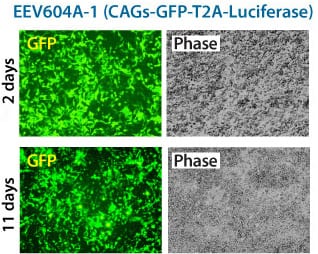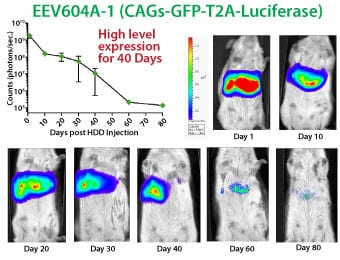CAGs-GFP-T2A-Luciferase Enhanced Episomal Vector (EEV)
- High levels of expression
- Easy to clone formats
- No special plasmid production
- Nonviral, non-integrating technology
- Constitutive and inducible vector formats
Products
| Catalog Number | Description | Size | Price | Quantity | Add to Cart | |||
|---|---|---|---|---|---|---|---|---|
| EEV604A-2 | CAGs-GFP-T2A-Luciferase Dual Reporter Enhanced Episomal Vector (EEV) (Replaces EEV604A-1) | 10 µg | $719 |
|
||||
Overview
Overview
An easy-to-produce non-integrating option for constitutive GFP and luciferase expression
With virtually no limits on insert size (unlike AAV vectors) Enhanced Episomal Vectors (EEVs) are an excellent choice for non-integrating, non-viral gene expression. Because they replicate in synchrony with the host cell, they are stably inherited and can be used for long-lasting expression—up to several months both in vitro and in vivo—without modifying the host genome. Use SBI’s CAGs-GFP-T2A-Luciferase EEV Vector (Cat.# EEV604A-2) for constitutive, CAG-driven coordinated expression of GFP and luciferase reporters in most cell types, including primary cells and stem cells.
 SBI’s EEV System, which is an enhanced version of the Epstein-Barr Nuclear Antigen-1 (oriP-EBNA1) system, offers:
SBI’s EEV System, which is an enhanced version of the Epstein-Barr Nuclear Antigen-1 (oriP-EBNA1) system, offers:
- High levels of expression
- Easy to clone formats
- No special plasmid production
- Nonviral, non-integrating technology
- Constitutive and inducible vector formats
References
How It Works
Supporting Data
Supporting Data
Sustained, non-integrating gene expression in vitro and in vivo with EEV
Figure 1. A constitutive EEV reporter based on CAGs-MCS delivers similar amounts of GFP expression in vitro after two days and eleven days. SBI’s EEV reporter plasmid CAGs-GFP-Luciferase (Cat.# EEV604A-2), contains a GFP-T2A-Luciferase cassette cloned into the CAGs-MCS EEV Vector (Cat.# EEV601A-1). This plasmid was transfected into HEK293T cells (0.5 µg of CAGs-GFP-Luciferase in a 24-well plate) and GFP transgene expression imaged. There is little change in GFP signal between two- and eleven-days post-transfection.
Figure 2. A constitutive EEV reporter based on CAGs-MCS delivers high levels of expression in mice over forty days. 8 µg of the constitutive CAGs-GFP-T2A-Luc construct (Cat.# EEV604A-2) was introduced into test mice through hydrodynamic tail vein injection (HDD), a procedure which leads to high plasmid DNA transfection of the livers of mice in vivo. The test mice (n=3) were imaged for body luminescence in the liver area post-HDD from Day 1 up until Day 80. The results show that robust EEV-expressed luciferase expression is readily detectable at very high levels through day 40.
FAQs
Documentation
Citations
Related Products
Products
| Catalog Number | Description | Size | Price | Quantity | Add to Cart | |||
|---|---|---|---|---|---|---|---|---|
| EEV604A-2 | CAGs-GFP-T2A-Luciferase Dual Reporter Enhanced Episomal Vector (EEV) (Replaces EEV604A-1) | 10 µg | $719 |
|
||||
Overview
Overview
An easy-to-produce non-integrating option for constitutive GFP and luciferase expression
With virtually no limits on insert size (unlike AAV vectors) Enhanced Episomal Vectors (EEVs) are an excellent choice for non-integrating, non-viral gene expression. Because they replicate in synchrony with the host cell, they are stably inherited and can be used for long-lasting expression—up to several months both in vitro and in vivo—without modifying the host genome. Use SBI’s CAGs-GFP-T2A-Luciferase EEV Vector (Cat.# EEV604A-2) for constitutive, CAG-driven coordinated expression of GFP and luciferase reporters in most cell types, including primary cells and stem cells.
 SBI’s EEV System, which is an enhanced version of the Epstein-Barr Nuclear Antigen-1 (oriP-EBNA1) system, offers:
SBI’s EEV System, which is an enhanced version of the Epstein-Barr Nuclear Antigen-1 (oriP-EBNA1) system, offers:
- High levels of expression
- Easy to clone formats
- No special plasmid production
- Nonviral, non-integrating technology
- Constitutive and inducible vector formats
References
How It Works
Supporting Data
Supporting Data
Sustained, non-integrating gene expression in vitro and in vivo with EEV
Figure 1. A constitutive EEV reporter based on CAGs-MCS delivers similar amounts of GFP expression in vitro after two days and eleven days. SBI’s EEV reporter plasmid CAGs-GFP-Luciferase (Cat.# EEV604A-2), contains a GFP-T2A-Luciferase cassette cloned into the CAGs-MCS EEV Vector (Cat.# EEV601A-1). This plasmid was transfected into HEK293T cells (0.5 µg of CAGs-GFP-Luciferase in a 24-well plate) and GFP transgene expression imaged. There is little change in GFP signal between two- and eleven-days post-transfection.
Figure 2. A constitutive EEV reporter based on CAGs-MCS delivers high levels of expression in mice over forty days. 8 µg of the constitutive CAGs-GFP-T2A-Luc construct (Cat.# EEV604A-2) was introduced into test mice through hydrodynamic tail vein injection (HDD), a procedure which leads to high plasmid DNA transfection of the livers of mice in vivo. The test mice (n=3) were imaged for body luminescence in the liver area post-HDD from Day 1 up until Day 80. The results show that robust EEV-expressed luciferase expression is readily detectable at very high levels through day 40.



